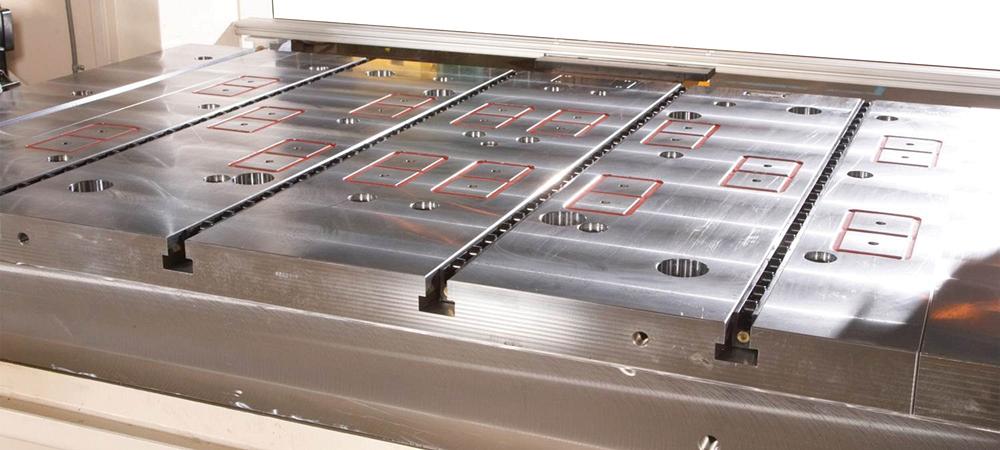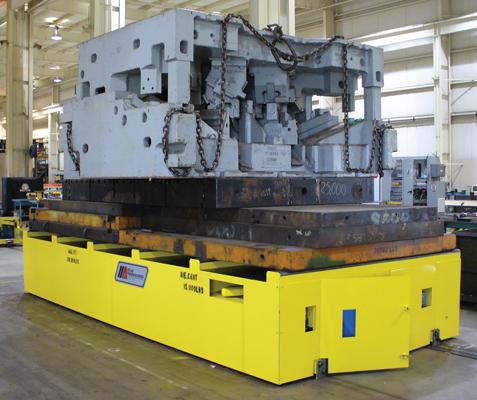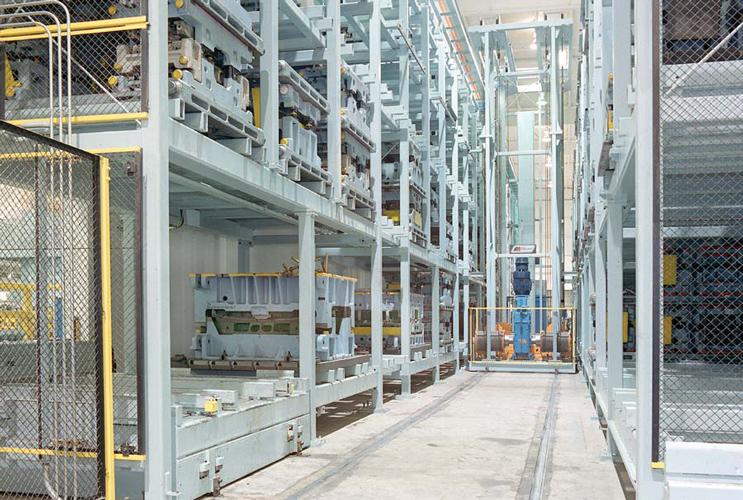Contributing editor
- FMA
- The Fabricator
- FABTECH
- Canadian Metalworking
Categories
- Additive Manufacturing
- Aluminum Welding
- Arc Welding
- Assembly and Joining
- Automation and Robotics
- Bending and Forming
- Consumables
- Cutting and Weld Prep
- Electric Vehicles
- En Español
- Finishing
- Hydroforming
- Laser Cutting
- Laser Welding
- Machining
- Manufacturing Software
- Materials Handling
- Metals/Materials
- Oxyfuel Cutting
- Plasma Cutting
- Power Tools
- Punching and Other Holemaking
- Roll Forming
- Safety
- Sawing
- Shearing
- Shop Management
- Testing and Measuring
- Tube and Pipe Fabrication
- Tube and Pipe Production
- Waterjet Cutting
Industry Directory
Webcasts
Podcasts
FAB 40
Advertise
Subscribe
Account Login
Search
How quick die change is changing
Now more hands-free, controlled, mainstream
- By Kate Bachman
- May 12, 2014
- Article
- Bending and Forming

Most die handling OEMs offer magnetic clamping, which clamps existing dies without retooling. Newer magnetic clamp systems have force evaluation systems, which analyze the clamp conditions and provide the resultant magnetic clamp force on the die set. Photo courtesy of Atlas Technologies, Fenton, Mich.
Quick die change (QDC), introduced decades ago, has become a staple of lean manufacturing in most stamping shops. Elimination of much of the lengthy press setup times and press downtime attributed to die change in the past advances just-in-time manufacturing. Still, many stampers are in the process of converting some operations to QDC, improving their methods of doing so, or speeding the process even more.
QDC equipment itself—mechanical, magnetic, hydromechanical, hydraulic, spring, electromechanical, swing, sliding, swing sink, wedge, and traveling die clamps; ball, roller, hydraulic, and spring die lifters, bolster extensions, rails, controllers and aligners; carts, T-tables and power pallets; and controls—is being upgraded and their lines expanded to meet evolving requirements for speed and safety (see Figure 1).
Several die change equipment manufacturers told STAMPING Journal what their customers tell them about their challenges with die handling and changeover.
Atlas Technologies Inc. Director of Sales and Applications Bill Rogner said, “We find that stampers are faced with adding jobs to their press cells. These additional jobs require that their press cells must run faster or have more uptime.”
In addition to the increased production stress, manufacturers are faced with die storage and handling problems, Rogner added. “Often dies may be stored outdoors or stacked inside at multiple tiers. These storage methods are not ideal for efficiency, safety, or part quality.”
David L. Fischer, Hilma engineering manager, Carr Lane Roemheld Mfg. Co., pointed to production volume variation as a push for even faster die changeovers and economical die clamp and handling systems. “Shorter runs and more frequent die changes mean more press downtime. So die changes must be quicker.” He added this caveat: “But safety cannot be sacrificed for speed; they need safe clamping systems and ergonomic die exchanges.” (See Figure 2.)
Chris Keahn is North American sales manager at Tecnomagnete, which makes quick-change magnetic clamping only. He concurred that accelerating die changeover time is still a challenge. “Speeding up quick die changeover time is the main reason people come to us.”
In the May/June 2013 STAMPING Journal article “Quick die change: About the time in between,” p. 24, Serapid Inc.’s Carol Herriges, marketing manager, and John Remington, QDX sales manager, pointed to the efficiencies gained by moving activities from the “internal” time period to the “external” time period. That is to say, stampers can reduce downtime during die changeover by performing coil line threading, adjustments, lubrication setup, and similar activities while the press is running to reduce downtime.
The OEMs relayed what they are doing to help stampers manage those challenges.
SJ: How is your equipment and technology evolving to help meet challenges? What have you done with QDC technology that is new?

Figure 1
Transporting huge and heavy dies via transport carts on tracks has become a mainstream
method of moving them safely and without manual handling by overhead
cranes or forklifts. Photo courtesy of Atlas Technologies, Fenton, Mich.
Rogner, Atlas: We look at each press cell individually and implement equipment strategies that increase press uptime and make die handling easier and safer. Each individual solution is tailored to the customer’s specific situation.
At a more technical level, we utilize the latest technologies in drive systems and positioning feedback to enhance responsiveness and reliability.
Automated storage and retrieval systems help stamping companies manage die storage and handling issues too [see Figure 3].
Fischer, Hilma: We have a variety of products that can provide custom clamping and handling for most applications, with a mix of standard products.
Newer components include smaller and more economical electrical and pneumatic power units, suitable for small and midsize QDC systems and presses.
Additional die handling products include hydraulic or spring-actuated ball and roller lifters. The positions and spacing of balls and rollers in the lifter bars can be adjusted to fit the application. This can greatly reduce costs when moving lighter dies. Ergonomic hydromechanical manual clamps, with clamp force indicator pins, can provide high clamp forces and very little tightening torque.
Keahn, Tecnomagnete: We have reduced the thickness of our magnetic plates. When retrofitting a press with magnetic clamping, we can now minimize the amount of daylight the plates displace.
Herriges, Remington, Serapid: Die lifters often can help cut adjustment time, and easily adjustable or fully automated clamps can simplify the setup. Other options are die subplates, bolster extensions, and a die changer [see Figure 4].
SJ: What clamping types, die transport styles, and die lift styles are available, and how do stampers choose which is right for their operation?
Rogner, Atlas: We support many types of upper die clamping systems. Generally, hydraulic, magnetic, or manual upper clamping is used [see lead image]. A detailed cost-benefit analysis is required to evaluate clamping methods. In addition, safety and plant personnel involved in the die change process should play a role in the decision-making.

Figure 2
Sliding clamps with hydraulic die lifters
and pivoting die support arms on the
slide and bolster aid in ergonomic, safe
die clamping and handling. Photo courtesy
of Hilma Engineering, Carr Lane
Roemheld Mfg Co., Fenton, Mo.
Regarding die transporting, we see a significant increase in interest in trackless die transporters. Die lifters are available in spring, pneumatic, and hydraulic models [see Figure 5]. These are used based on die weight and bolster configuration.
Fischer, Hilma: We work directly with the user to customize a system for their needs. This includes types and quantities of clamps, die rollers, die supports, pumps, and valves [see Figure 6].
Keahn, Tecnomagnete: A wide range of clamping devices are available these days, but we specialize in magnetic clamping. I commonly see die lifters being used with our plates to allow for quick removal and the ability to line up tools quicker by adding locating holes.
SJ: How has QDC evolved since it first was introduced? Without divulging trade secrets, in a general way, what innovations can stampers expect to see next year? In the future?
Rogner, Atlas: The use of the manually controlled overhead crane in die change and die handling will be reduced or eliminated. Die change functions, press changeover, and automation changeover will evolve into a more integrated function. Magnetic die clamping will become a more accepted method for clamping dies in presses. This method of clamping has some obstacles in implementation, but once this method is fully understood, the benefits of such systems are substantial.
Fischer, Hilma: Some customers require hands-free clamping in die change systems, which means auto- positioning and automatic clamp equipment with multiple proximity switches, to integrate the clamp position and status to the press controls. Electromechanical clamps for hydraulic-free applications are another. Magnetic clamp systems with force evaluation systems analyze the clamp conditions and provide the operator with the resultant magnetic clamp force on the die set.
Herriges, Remington, Serapid: The most complete—and initially the most expensive—option is a fully automated system that can move dies from storage to the press, clamp them, take out the die that’s no longer needed, and store it while staging the next die at the press, all without operator intervention. Typically considered with greenfield sites, or completely new plant construction, this system removes a lot of the potential for error, makes the best use of the shop floor, nearly eliminates wasted internal time, and often provides the best savings over time.
Keahn, Tecnomagnete: When we first developed magnetic clamping, our magnetic plates were 2 in. thick. Now we have them down to 1.47 in., so we have decreased the amount of daylight being lost. We have added a dual mag feature which eliminates vibrations between the magnets and press slide or bolster.
About the Author

Kate Bachman
815-381-1302
Kate Bachman is a contributing editor for The FABRICATOR editor. Bachman has more than 20 years of experience as a writer and editor in the manufacturing and other industries.
subscribe now

The Fabricator is North America's leading magazine for the metal forming and fabricating industry. The magazine delivers the news, technical articles, and case histories that enable fabricators to do their jobs more efficiently. The Fabricator has served the industry since 1970.
start your free subscription- Stay connected from anywhere

Easily access valuable industry resources now with full access to the digital edition of The Fabricator.

Easily access valuable industry resources now with full access to the digital edition of The Welder.

Easily access valuable industry resources now with full access to the digital edition of The Tube and Pipe Journal.
- Podcasting
- Podcast:
- The Fabricator Podcast
- Published:
- 04/16/2024
- Running Time:
- 63:29
In this episode of The Fabricator Podcast, Caleb Chamberlain, co-founder and CEO of OSH Cut, discusses his company’s...
- Trending Articles
AI, machine learning, and the future of metal fabrication

Employee ownership: The best way to ensure engagement

Steel industry reacts to Nucor’s new weekly published HRC price

Dynamic Metal blossoms with each passing year

Metal fabrication management: A guide for new supervisors

- Industry Events
16th Annual Safety Conference
- April 30 - May 1, 2024
- Elgin,
Pipe and Tube Conference
- May 21 - 22, 2024
- Omaha, NE
World-Class Roll Forming Workshop
- June 5 - 6, 2024
- Louisville, KY
Advanced Laser Application Workshop
- June 25 - 27, 2024
- Novi, MI



























